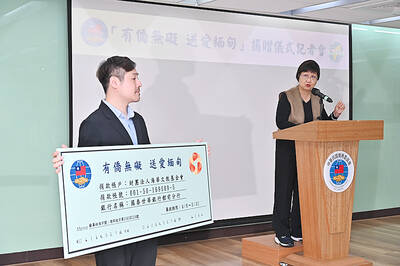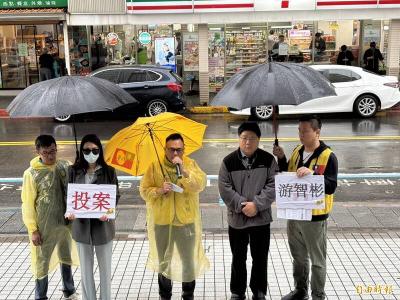The latest poll by National Chengchi University’s Election Study Center showed a record-low 9.1 percent of respondents support unification with China, and a record-low 3.3 percent regard themselves as Chinese.
The poll is part of a study that has been ongoing since 1992 on political attitudes, including on the unification-independence issue, national identity and political party preference.
The latest figures, gathered last month, showed that 59 percent of respondents identify themselves as Taiwanese, a slight drop from 60.6 percent in December last year.
The poll found 33.7 percent of respondents said they are both Taiwanese and Chinese, increasing slightly from 32.5 percent last year, and those identifying themselves as solely Chinese dropped to a historical low of 3.3 percent.
The poll found 21.1 percent of respondents said they support Taiwanese independence or would favor an immediate declaration of independence, lower than 23.9 percent last year.
The number of people who support unification or lean toward immediate unification reached a historical low of 9.1 percent.
Support for the Democratic Progressive Party (DPP) has risen from 26.7 percent last year to a record-high 29.7 percent, while support for the Chinese Nationalist Party (KMT) dropped from 22.9 percent last year to 21 percent, its lowest since 2003.
Support for the People First Party increased from 2.7 percent last year to 3.9 percent this year, the highest since 2006.
Saying that the data showed the long-term tendency of Taiwanese core attitudes and identifications, DPP Legislator Lee Chun-yi (李俊俋) said the percentage of people who identify themselves as Taiwanese has soared from 48.4 percent in 2008 to 59 percent this year due to a series of pro-China policies launched by President Ma Ying-jeou (馬英九) since he took office in 2008.
The number of people who regard themselves as Chinese has fallen from 4 percent in 2008 to 3.3 percent this year and has yet to hit the bottom, which shows that the Taiwanese do not want Taiwan to be a part of China, Lee said.
Support for the KMT has plummeted from the historical high of 39.5 percent in 2011 to 21 percent this year, while support for the DPP has steadily climbed from 19.5 percent in 2009 to 29.7 percent this year, he said.
The rise and fall are the results of the KMT’s poor performance and the DPP’s ability to put forward clear policies and define the direction of reform, such as the proposal of developing renewable resources to bring about a nuclear-free homeland and an elaborated platform of the long-term care to provide for the aging population, he said.
However, the KMT and the Ma administration have turned their backs on public opinion, which is evident in a forceful implementation of a set of high-school curriculum guidelines that critics said are unprofessional and historically incorrect, while the government insists on pressing charges against students who stormed the headquarters of the Ministry of Education in Taipei on Thursday to protest against the curriculum, Lee said.

DEFENSE: The National Security Bureau promised to expand communication and intelligence cooperation with global partners and enhance its strategic analytical skills China has not only increased military exercises and “gray zone” tactics against Taiwan this year, but also continues to recruit military personnel for espionage, the National Security Bureau (NSB) said yesterday in a report to the Legislative Yuan. The bureau submitted the report ahead of NSB Director-General Tsai Ming-yen’s (蔡明彥) appearance before the Foreign and National Defense Committee today. Last year, the Chinese People’s Liberation Army (PLA) conducted “Joint Sword-2024A and B” military exercises targeting Taiwan and carried out 40 combat readiness patrols, the bureau said. In addition, Chinese military aircraft entered Taiwan’s airspace 3,070 times last year, up about

A magnitude 4.3 earthquake struck eastern Taiwan's Hualien County at 8:31am today, according to the Central Weather Administration (CWA). The epicenter of the temblor was located in Hualien County, about 70.3 kilometers south southwest of Hualien County Hall, at a depth of 23.2km, according to the administration. There were no immediate reports of damage resulting from the quake. The earthquake's intensity, which gauges the actual effect of a temblor, was highest in Taitung County, where it measured 3 on Taiwan's 7-tier intensity scale. The quake also measured an intensity of 2 in Hualien and Nantou counties, the CWA said.

The Overseas Community Affairs Council (OCAC) yesterday announced a fundraising campaign to support survivors of the magnitude 7.7 earthquake that struck Myanmar on March 28, with two prayer events scheduled in Taipei and Taichung later this week. “While initial rescue operations have concluded [in Myanmar], many survivors are now facing increasingly difficult living conditions,” OCAC Minister Hsu Chia-ching (徐佳青) told a news conference in Taipei. The fundraising campaign, which runs through May 31, is focused on supporting the reconstruction of damaged overseas compatriot schools, assisting students from Myanmar in Taiwan, and providing essential items, such as drinking water, food and medical supplies,

New Party Deputy Secretary-General You Chih-pin (游智彬) this morning went to the National Immigration Agency (NIA) to “turn himself in” after being notified that he had failed to provide proof of having renounced his Chinese household registration. He was one of more than 10,000 naturalized Taiwanese citizens from China who were informed by the NIA that their Taiwanese citizenship might be revoked if they fail to provide the proof in three months, people familiar with the matter said. You said he has proof that he had renounced his Chinese household registration and demanded the NIA provide proof that he still had Chinese